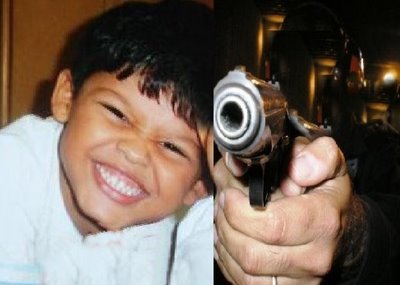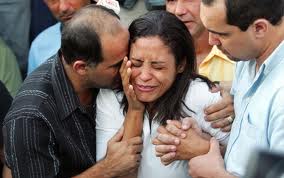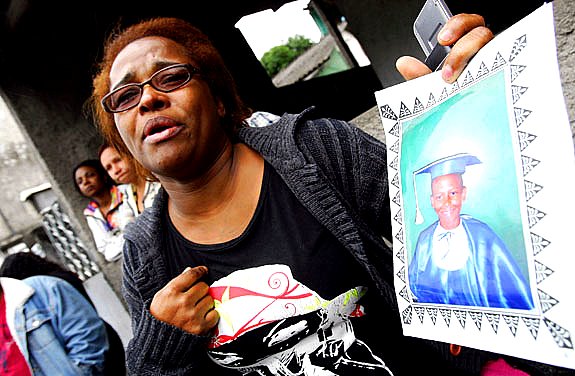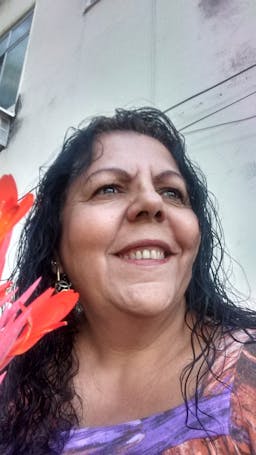The pain of La Pietà in the slums and roads of Rio de Janeiro.
Jan 21, 2015
Story





I did not believe the pain my aunt and my cousins were feeling when they made the decision to donate the organs of my deceased nephew. Doctors and psychologists were running up and down in favor of other lives that dependend on this decision. We lost hope of seeing João Roberto return home
The beginning of our pain. The mother returned home with her children after visiting her family. She was in the car with her two sons when she heard the police car’s siren. She could see through the mirror that the police was chasing a criminal. She gave way so the police could pass.
From that moment on, the fate of her eyes would be tears and the fate of her heart, pain.
The police officers left their car, holding guns and shot Alessandra’s car. She panics and tries to calm her son, so she tells him to lie down. João Roberto asks: “Lie down? Why mommy?”. In the backseat, João Roberto Amorin, three years old, is shot in the head. His 10 month old brother watches everything
The mother in shock throws the child’s bag through the window in order to show the police that they were shooting in the wrong car.
The camera of a residential building records the disastrous approach of the police against Alessandra’s car. João Roberto Amorim is one more child murdered by the state police. The governor of Rio de Janeiro at the time said he would fire the police officers. After three years of this event, the responsible officers were still not fired, are in freedom – while João’s family mourns and seeks justice.
The family is in mourning. The crime is slowly forgotten with the passage of time. The cycle of killing continues because of the technical inefficiency of those who should be able to guard and protect the greater good of a country, its people and especially the most vulnerable ones: children and the youth.
What about the death of João Roberto?
Scenes of the police approaching the family car were recorded and the family drama had national repercussion. The government promised they would take action to punish the executors of the child. However, the cops who shot 16 bullets into Alessandra’s car and killed the boy remain free. As a mother, she continues to mourn. She feels the pain of the relentless pursuit of justice.
João Roberto Amorim, three years old, lived in Grajaú. Agata dos Santos, 11 years old, lived in the favela of Rocinha. Hugo Cavalcanti, 12 years old, lived in Leblon. Gilbert Wesley Rodrigues de Andrade, 11 years old, shot dead inside his school, lived in Costa Barros. Adrielly, 7 years old, lived in Quentino. Allana, 14 years old, lived in the slums of Dende.
Abram Maximilian, 15 years old, lived in the slums of the “Complexo do Alemão”. William de Oliveira, 8 years old, lived in the favela “Morro do Chapadão”. Juliana Rodriguez, six years old, lived in “Ilha do Governador”. Marlysson Ribeiro Pereira, 12 years old, lived in “Vila Kennedy”. All of them children. Each one of them from a different neighborhood in Rio de Janeiro. All of them add to the statistics of people killed by lost bullets in Rio.
All of them represented broken dreams: the breaking down of a family. The internal destruction is so deep that only the Carrara marble carved by Michelangelo, in every part, every curve and detail of his work La Pietà, is able to record a small part of the scars that bleed into the hearts of each mother and each of us.
When one child dies in such a tragic manner, the families – and especially the women – of children who had had a similar fate organize to help, no matter in what neighborhood the child died. They help families who are suffering now the loss they also have suffered. The victim becomes their own executed child. They follow along with the family until the funeral and join a network to provide guidance to families in mourning.
When these mothers see the dead child, they act as if there was their own son: some scream, faint, go into emotional crisis as the mothers relieve the pain of losing a child again.
It is an endless pain, pain without an answer, a pain that only those who lost a son in tragic death as they did know the depth.
The feelings experienced by mothers are beyond the pain of losing a loved one. A moral pain is created with false information, pre-judgment about the crime to tarnish the image of the dead. The victim becomes responsible for his or her own death.
In the video of the funeral of Matheus, only 8 years old, killed by a stray bullet, the family’s pain is huge and audible. The voice saying "Why did they kill my son?" belongs to his mother, Mrs. Glaciene Rodrigues dos Santos, in the lament of his bloody pain.
He had gone to a nearby bakery to buy bread when he was hit by a bullet. He immediately fell on the ground with a $ 1.00 coin in one of his hands.
For Glaciene’s question, there are no answers. If there is no one to blame, there is no crime? The expected response to a murder is the punishment of murderers.
The death of Mrs. Ana Cristina Ribeiro’s son, a boy who loved football and had the dream of becoming a player, showed that in areas of conflict, there is no safety even within one’s home. Marlysson was inside, lying on the sofá, when he was hit by a bullet and died.
Families around the world believe that their child is safe when parents are close to them or when they are inside their homes. The barriers created by their families to protect children are not strong enough to protect them from the powerful weapons that are recklessly handled by both police officers and criminals in Rio de Janeiro.
“On Saturday he was my son. Today he is a number in statistics. I pay my taxes and my son kept under my wing, but I could not protect him even at home”, says Ana Cristina Mother, Marlysson’s mother.
Most executors are police officers when they have to approach the slums for an operation. Some cases are also occurring with military personnel. Most of the weapons that killed these children have been used by the police.
How can these families resume their lives if they are stuck in a web of pain and fear? There is a lack of legal compliance with their loss. The least they seek is justice.
The families who lost children found support in a "Community Network Against Violence and Social Movements." The network is located in downtown Rio de Janeiro.
It is a movement against state violence and human rights violations committed by representatives of the state itself in communities and slums. The organization was established in 2004, and it counts on people from the communities and human rights activists.
It is a statewide network, but because it has protected people in other states and countries, it could be considered an international network.
The organization has won awards for its outstanding work.
It offers a space of listening to these families as well as support and guidance on how to act in the face of pain. As a supportive space where the family has a voice, the organization offers psychological and legal consultations.
It does not have a source of statistics about the cases treated, making it difficult to compare the official numbers on victims of stray bullets with the organization’s outcomes.
They are currently experiencing another kind of phenomenon in the slums: many young people are going missing.
In an interview for a website page Diary of a judge posted on August 8, 2010, Attorney Mark Andrew Chut, who works for Rio’s Public Ministry, refers to these cases of youths gone missing:
"One does not need the victim’s body to prove a crime. It is enough to have the ‘corpus delicti’. That is, a set of material traces of a crime. If it is the victim's body, better. But other elements are also useful, such as blood and bones. Materiality can be proven indirectly, through evidence, testimony and forensic evidence."
The experts say in the absence of material evidence of the victim's death, the Brazilian Code of Criminal Procedure authorizes testimonials of witnesses to serve as enough proof to carry on the prosecution of suspects.
It is already difficult enough to prosecute the murderers when there are video cameras filming the crime, as in the case of João Roberto Amorim. In this case, there was his lifeless body and other material evidence. So there was no question on who were the perpetrators or whether the crime had actually happened. These facts were given. But what about a situation in which a son disappears and the mother only knows he's dead because someone told her?
It is virtually impossible to find the perpetrator.
Apart from the suffering, the mother’s pain does not materialize. She cannot bury her child, even if she has information on the death of his son. There is hope of finding him all day, even if only his lifeless body.
Women, especially those who fight for their rights, still have the fear of retaliation. Some are forced to abandon homes or the country because of the threats.
The Network gives support for complaints, at national and international cases of violence and rights violations by the state in communities.
Marcia Jacintho also belongs to the Network. She had her son, Henry Silva Gomes, executed at age 16. She studied law in order to prove the innocence of her son. She investigated the case on her own and was able to prove that the military police killed him.
"The investigation that our justice system would not want to do, I did on my own." said Marcia.
Marcia says in her speech that the state of Rio criminalizes poverty.
Marcia was honored with the award “Making a Difference”. She dedicated it with emotion to an audience with a standing ovation, saying: "This trophy is ours, the parents who lost children to the State of Rio."
The Network has won several awards. A documentary "Between the walls and slums" in the Exhibition International Ethnographic Film, also received the "Chico Mendes Resistance Medal 2007" Award and the Special Secretariat for Human Rights of Presidency of the Republic.
Luis Carlos Nascimento’s documentary "Mourning as a mother" shows the struggle of women who lost their relatives executed by agents of the state of Rio de Janeiro. It tells the story of five women in this group of mourning rite of passage for justice and the fight against invisibility.
Professor Maria Helena Moreira Alves, PhD in political science from MIT (Massachusetts Institute of Technology), resident in Chile, a militant in the area of Human Rights, said in Skaype interview about the launch of the book "Living in the Crossfire: Favela Residents, drug dealers and police violence in Rio de Janeiro. She affirms: "This book shows the fragility of families before the confrontation and the fate of the projectiles that lose control and find themselves in the deep pain of a mother."
La Piedà! Pitié! 遺憾! Lástima! Jammer! Mitleid! Piedade! Escutem o grito das mães! Elas imploram, querem abraçar a justiça, ouçam o grito da Boca do Mundo. O grito da dor da perda.
La Pied! Pitié! 遗憾! Alas! Jammer! Mitleid! Mercy! Hear the cry of mothers! They beg, they want to embrace justice, hear the cry of the Mouth of the World. The cry of grief. ‘voice of the world’.
May justice find the truth of each crime. That every murderer finds a punishment. Not escape the control of the state the responsibility of each act of the causative agent of emotional loss of these families.
May justice wipe the tears of the mothers condemning the murderers of their children.
This production was originally written in Portuguese.
This article is part of a writing assignment for Voices of Our Future a program of World Pulse that provides rigorous
new media and citizen journalism training for grassroots women leaders. World Pulse
lifts and unites the voices of women from some of the most unheard regions of the
world.




